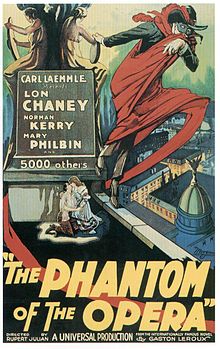
Back شبح الأوبرا (فيلم 1925) Arabic شبح الاوبرا (فيلم 1925) ARZ The Phantom of the Opera (pel·lícula de 1925) Catalan Das Phantom der Oper (1925) German Το Φάντασμα της Όπερας (ταινία) Greek The Phantom of the Opera (filmo, 1925) Esperanto El fantasma de la ópera (película de 1925) Spanish Ooperifantoom (film 1925) Estonian The Phantom of the Opera (1925eko filma) Basque شبح اپرا (فیلم ۱۹۲۵) Persian
| The Phantom of the Opera | |
|---|---|
 Theatrical release poster | |
| Directed by |
|
| Screenplay by |
|
| Based on | The Phantom of the Opera 1910 novel by Gaston Leroux |
| Produced by | |
| Starring | |
| Cinematography | |
| Edited by |
|
| Music by | Gustav Hinrichs |
Production company | |
| Distributed by | Universal Pictures |
Release dates |
|
Running time |
|
| Country | United States |
| Language | Silent (English intertitles) |
| Budget | $632,357.[1] |
| Box office |
|
The Phantom of the Opera is a 1925 American silent horror film adaptation of Gaston Leroux's novel of the same name directed by Rupert Julian and starring Lon Chaney in the title role of the deformed Phantom who haunts the Paris Opera House,[2] causing murder and mayhem in an attempt to make the woman he loves a star. The film remains most famous for Chaney's ghastly, self-devised make-up, which was kept a studio secret until the film's premiere. The picture also features Mary Philbin, Norman Kerry, Arthur Edmund Carewe, Gibson Gowland, John St. Polis and Snitz Edwards. The last surviving cast member was Carla Laemmle (1909–2014), niece of producer Carl Laemmle, who played a small role as a "prima ballerina" in the film when she was about 15 years old. The first cut of the film was previewed in Los Angeles on January 26, 1925. The film was released on September 6, 1925, premiering at the Astor Theatre in New York.
In 1953, the film entered the public domain in the United States because the film's distributor Universal Pictures did not renew its copyright registration in the 28th year after publication.
- ^ Blake, Michael F. (1998). "The Films of Lon Chaney". Vestal Press Inc. p. 150. ISBN 1-879511-26-6.
- ^ Harrison's Reports film review; September 17, 1925, p. 151.